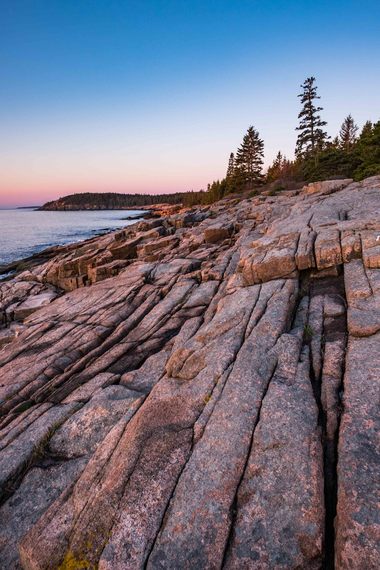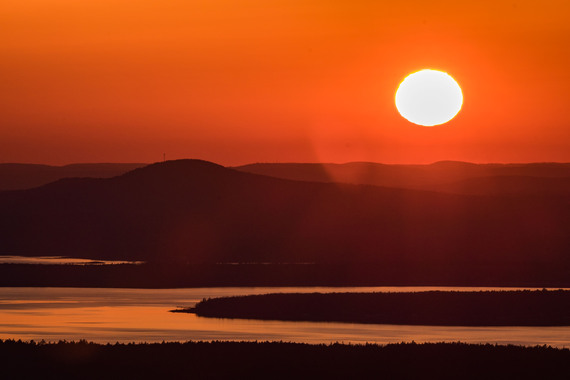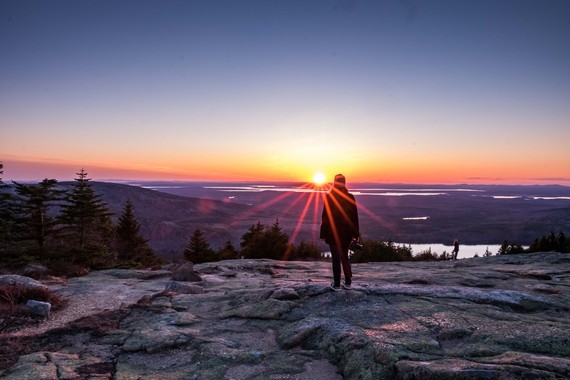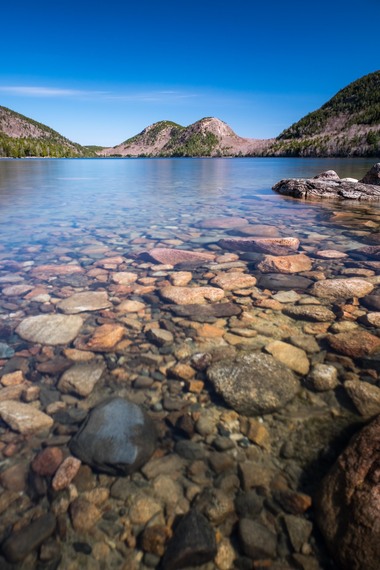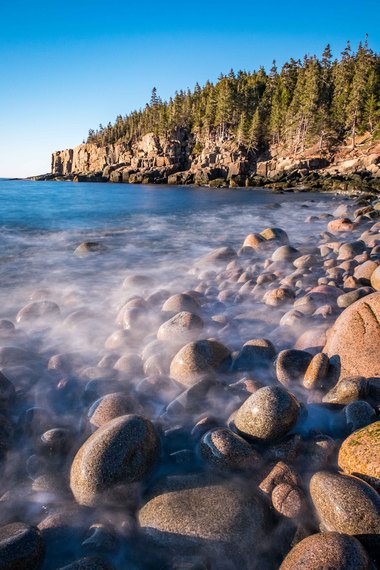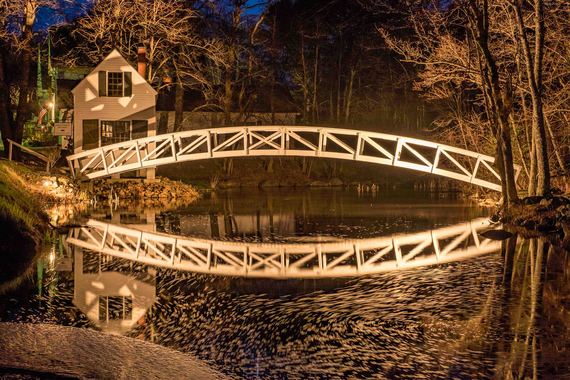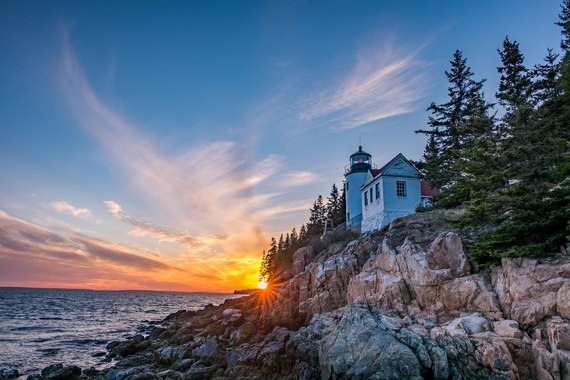Acadia National Park, located on the eastern coast of the beautiful state of Maine, is a photographer's dream. Photographers have long been drawn to the rugged coastlines, iconic lighthouses, and warm tones of the northern light. If you are looking to visit this park and are interested in capturing beautiful photography while there, here's a list of seven great places where you are guaranteed to get a great shot.
#1 The Coastal Trail (from Sand Beach to Otter Point)
Without a doubt, this is the one of the most beautiful places within the park. The coastal trail follows perhaps the prettiest stretches of rugged coastline you will ever see. Easily accessible by car along the main park loop, it is a great place to periodically stop, get out, and play with the camera when so inspired.
What to shoot: I suggest that you look for leading lines in the rock that draw the eye down the coastline, such as the example pictured right. The sun rising above the trees is also a beautiful sight.
How to get here: Sand Beach (the start of the coastal trail) is located a half mile past the NPS Sand Beach entrance station along the main park loop. You can park at Sand Beach and walk the two-mile trail to Otter Point, or simply drive along the trail on the Park Loop Road (there are plenty of parking opportunities along the way.)
Best time to shoot: This is a sunrise location, and is best photographed before early afternoon.
Equipment suggestions: A wide-angle lens (in the 16mm to 24mm range) is best for capturing the detail in the rock and the distant horizon. I also liked having a longer lens (in the 200mm range) for distant details and wildlife (mostly bird) opportunities.
Other suggestions: While I didn't shoot any nighttime shots here, I do think it would be a great place for astrophotography.
The Coastal Trail. Photo credit: Jonathan Irish
#2 Cadillac Mountain
The tallest mountain within 25 miles of the shoreline on the east coast of the United States is Cadillac Mountain, a must-see during any visit to Acadia National Park.
What to shoot: The sun! Rising and falling. Try to capture people in the shot, as they add a sense of place, scale, and emotion. The pink granite rock underfoot, when wet, can take on the beautiful warm colors of the sunset or sunrise, so keep an eye out for that.
How to get here: From the park loop road, take the 3.5-mile road up to the summit. There are plenty of places to stop along the way.
Best time to shoot: Cadillac Mountain is great both at sunrise and sunset. I prefer sunrise, as there are less crowds (it can get pretty crowded here at dusk during the summer) and I like the views eastward over the distant islands.
Equipment suggestions: A wide-angle lens (in the 16mm to 24mm range) is best.
Sunset at Cadillac Mountain. Photo credit: Jonathan Irish
#3 Schooner Head
Schooner head is a short stop-off along the Park Loop Road, and I would bet most people don't get here if they are focused on the scenic drive alone. But they would miss out on a really nice little area for photography; one that resembles the Coastal Trail but is shorter and more private.
What to shoot: I drove here several times and found it a great place for moody, dramatic photography when the temperamental Maine weather started to act up.
How to get here: Schooner Head can easily be accessed via the Park Loop Road on the east side of Mount Desert Island. From the Schooner Head lookout, take a short walk down to the coastline for the best views.
Best time to shoot: I loved being here when the weather was overcast and cloudy. For me, this is the ideal location for moody coastal shots.
Equipment suggestions: A medium wide-angle lens (in the 24mm range) is best for capturing the detail in the rock. I also enjoyed using a 10-stop (LEE Big Stopper) neutral density filter to blur the water and give the image a ghost-like feel to match the moody weather. A solid tripod, sturdy enough to stand up to the coastal winds, is essential here.
#4 Jordan Pond
I have to admit, I wasn't expecting much at this location, simply because I was focused on the coast. However, I loved photographing here so much that I came back twice. Besides being a fun place for photos, it is also a beautiful place to take a stroll around the lake.
What to shoot: Most photographs focus on the small protruding rocks at the south end of the pond while framing them with the two humps of the Bubble Mountains in the background.
How to get here: Jordan Pond is easily accessed along the western side of the Park Loop Road. Walk down the short trail from the Jordan Pond House and you will be right at the south side of the pond, with trails leading in both directions.
Best time to shoot: I found the late afternoon to be the best time to photograph here, as the light is best at that time.
Equipment suggestions: A wide-angle lens (in the 16mm to 24mm range) is best. I also suggest a tripod that you can rest on the small protruding rocks.
The beautiful still waters at Jordon Pond. Photo credit: Jonathan Irish
#5 Boulder Beach
While not officially called Boulder Beach, it has unofficially taken this name due to the seemingly impossibly smoothed basketball-size boulders that make up the rocky shore. These egg-shaped rocks have been tumbled 'round the pounding surf for millennia, and make for fantastic photo subjects.
What to shoot: The focus here is finding ideally shaped red granite boulders (perfectly round or egg-shaped), getting low to the ground, and framing them in the shot against the distant cliff. Try getting close to the water as well and catch the water breaking over the rocks, either with or without a neutral density filter.
How to get here: Boulder Beach is a stop along the coastal trail. Drive past the Gorham Mountain Trailhead some 500 feet and stop at the next small parking area. Take a walk down the short path to the beach.
Best time to shoot: This is a sunrise location, and is best photographed before early afternoon when the boulders take on the warm sunrise colors.
Equipment suggestions: A wide-angle lens (in the 16mm to 24mm range) is best for capturing the detail in the rock and the sea otter cliffs to the south. I suggest a tripod as well. Be sure to get low and close to the rocks.
#6 Somesville Bridge
While not officially located within the National Park boundaries, this is still a must-photograph for any visit to the area. Situated right next to the Selectmen's Building (built in 1780), the Somesville Bridge is something that you can't help but see and stop at when driving by. This idyllic white bridge spanning the small waterway is a fantastic location for photographs.
What to shoot: The Bridge! I personally liked getting close to the water opposite the bridge and shooting low from there, making sure to capture a strong reflection.
How to get here: Somesville is just over 8 miles west of Bar Harbor crossing the island on ME-233. It makes for a good stop on the way to (or back from) the Bass Harbor Lighthouse.
Best time to shoot: This location is good pretty much any time of the day, but I personally liked the bridge best at night when it is lit up with nice lighting. I used a long exposure (2-3 seconds) to blur the water underneath,
Equipment suggestions: A wide-angle lens (in the 20-24mm range) is best. I also liked to use a tripod here to shoot long exposures.
#7 Bass Harbor Head Light
The Bass Harbor Head Light is one of the most photographed (and photogenic) lighthouses in New England. Its stunning seaside location, perfectly perched upon the rocks, is breathtaking to behold. I loved this location so much that I had to go back a second time, and was even tempted to venture there a third. It is, without a doubt, one of the most beautiful sights you will see and photograph while visiting Acadia National Park.
What to shoot: Be sure to have a wide enough lens to capture the multi-colored rock below the lighthouse, the waves crashing on the rocks, the lighthouse above your head, and at least some of the trees and sky above that.
How to get here: The lighthouse is about 18 miles from Bar Harbor (roughly a half hour drive) on the south side of Mount Desert Island just off route ME-102. Once you park in the parking lot, walk east of the lighthouse down the path and you will find a small set of stairs leading down to the water. Take the stairs and situate yourself near the rocks. Take care to not setup too close to the water/waves, as the sea can be quite unpredictable, and the rocks are slippery.
Best time to shoot: This is both a sunrise and sunset location. Most photographers will visit during the sunset, simply because it is much easier than the really early Maine mornings at this latitude. I honestly don't have a preference, as both sunrise and sunset are spectacular here.
Equipment suggestions: A wide-angle lens (in the 16mm to 24mm range) is best for capturing the detail in the rock under the lighthouse and the lighthouse above. I also liked having a longer lens (in the 200-400mm range) for distant shots of the tree-lined coast against the setting sun (wait for a bird to fly through the shot for the most dramatic images). The setting sun behind the lighthouse produces a strong light/dark contrast, and I would suggest bracketing your shots (2-3 stops above and below) to be sure to capture shadow detail. A tripod is essential, whether shooting sunrise or sunset.
There are plenty of amazing photo locations within and near Acadia National Park. This is by no means a comprehensive list, but rather a general guideline for some sure-bet locations for great images. If you are visiting Acadia and want to take home some memorable photos, be sure to hit some, or all, of these amazing locations
